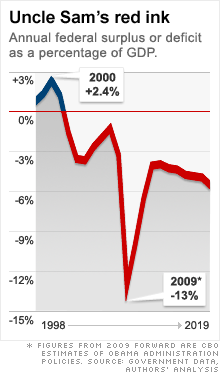Deficit: What caused it, why it matters
The government is spending more than it's bringing in. A lot more. The result is a deficit. Here's why that gap must be brought under control.

WASHINGTON (CNNMoney.com) -- When George Bush took office at the beginning of 2001, the federal government was running a substantial budget surplus and projected rising surpluses "as far as the eye could see." Now, the United States is facing massive current deficits -- as a share of the economy, the largest since World War II -- and an increasingly dire and unsustainable outlook over the next 10 years and beyond.
How did we get into this fiscal mess? To quote a character in Ernest Hemingway's classic novel, "The Sun Also Rises," when asked by another how he lost his wealth, "Two ways. Gradually and then suddenly."
The gradual part was a series of policy actions adopted during the Bush administration. In 2001, the Congressional Budget Office projected that the 2008 budget would show a surplus equal to 4.5% of gross domestic product. The actual 2008 budget ran a deficit of 3.2% of GDP. Almost all of the reversal was the result of policy changes -- tax cuts and spending increases.
Then, in 2009, the bottom fell out.
Financial markets collapsed and the economy went into a free fall. While the economy is beginning to show signs of stabilizing, the deficit has deepened and is on course to be roughly 13% of GDP this year. About two-thirds of the swing is due to the troubled economy and the other third due to policy responses to the downturn.
During a strong cyclical downturn, big deficits are not just a necessary evil but can actually do a fair amount of good. So, while the current deficit is striking, it is not a problem in and of itself, especially if it falls to more typical levels in the next few years.
The real problem is the medium- and long-term outlook.
Analysts have long emphasized that the country faces a long-term budget problem as a consequence of our rapidly growing old-age entitlement programs.
But now even the 10-year outlook is unsustainable. By 2019, even if everything goes the way the Obama administration wants, and the economy recovers and grows steadily over the next decade, the deficit will be 5.5% of GDP, an extremely high figure in good times, and the debt-to-GDP ratio will hit 82%, its highest level since just after World War II, and will keep rising.
And things aren't as likely to go as well as President Obama hopes. The economy has already performed worse than was assumed in the budget projections, and the projections are based on heroically optimistic assumptions about the political discipline Congress will impose on itself. And, of course, the problem will deepen, continually and inexorably, after 2019, as spending on Medicare, Medicaid and Social Security will grow rapidly.
Large chronic deficits are a serious economic problem. While much attention is given to the effect of deficits on interest rates, that effect is a symptom of a problem, not the problem itself.
If they are financed domestically, deficits will gradually divert capital from productive domestic uses, through a rise in interest rates. This diversion reduces the amount of capital available to U.S. workers, lowering their wages and hence their living standards. If our deficits are financed from abroad, interest rates may not rise as much, but interest payments on these deficits will flow back abroad.
In either case, the future national income of the United States and its citizens is reduced, businesses will find it harder to expand and homeowners will find it tougher to get credit.
Deficits can also affect the economy more suddenly. The prospect of large or out-of-control deficits can spark investors' fears and cause a run on the dollar and a sharp rise in interest rates.
President Obama and Congress need to address these looming fiscal shortfalls. But it's not that simple. The economy's health must be their primary concern, particularly with most projections seemingly pointing toward a slow, muted recovery after the current recession ends.
And this continuing economic weakness creates a difficult balancing act. Fiscal stimulus can help the economy in the short run, but fiscal discipline is needed in the long run.
So when should policymakers make the switch?
Imposing fiscal discipline too late risks precipitating a crisis in financial markets. Imposing fiscal discipline too soon risks weakening the recovery or worsening the recession, as actually happened in the United States in the 1930s.
The Great Depression actually consisted of two severe downturns, the second starting in 1937 when the federal government imposed fiscal restraint.
Policymakers can thread this needle by committing now to future spending cuts and tax increases, while at the same time being careful not to undo the current stimulus or hurt economic prospects right now. Getting this mix right will require luck, discipline, imagination and leadership.
Alan J. Auerbach is a professor of economics and law and director of the Burch Center for Tax Policy and Public Finance at the University of California, Berkeley. William G. Gale is vice president of the Brookings Institution and co-director of the Urban Institute-Brookings Institution Tax Policy Center, a nonpartisan organization that aims to educate and inform tax and fiscal issues for policy makers and the public. ![]()


